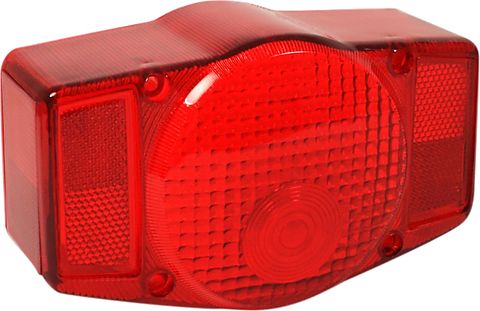Aesthetically, I like the CBR taillight. It seems to fit into the VMax space vacated by removing the red 'brick' of a stock taillight. I like the 'cat's-eye' light, and maybe the vintage replacement for the 'cat's-eye' taillight even-more.
But-and for me, safety trumps fashion every time as I have a strong instinct for self-preservation-I do think you're significantly cutting-down on your visibility to other road users to the rear, especially if you're a driver someplace besides directly-behind the bike, like in either lane to the flank positions.
This is especially-true of the 'clear' (translucent) lens 'tuck-away' rear taillights as are being replaced for the stocker.
Ever-notice how in a side shot of a VMax which has its stock lighting and reflective equipment, where a flash is used, what shows-up like a sore-thumb? The radiator reflector, and the rear taillight square side reflectors.
Tucking-away a low-profile light under the 'duckbill' of the rear fender is reducing your conspicuity by a significant amount. Also, when you run a 'clear' lens, your light just doesn't appear as-prominent to the eye, even-when you hit the brakes, which is a time when you need to be noticed the-most, to prevent being rear-ended. When your red-lensed taillight illuminates, the whole lens conducts light through it and yes, if you're running the stocker, it's a 'big, red (illuminated) brick'. When you run a clear lensed peek-a-boo low-profile light neatly-tucked-away under the duckbill, your visibility from a flanking position is much-less than the stocker. And, since many of these low-profile lamps are LED's they have a
very directional light output. If you are directly in-line w/it, yes, they can be very prominent. But, an incandescent has an
omni-directional light dispersion pattern, and therefore the entire lens conducts more light than the lens of a LED light. A clear LED light lens looks 'washed-out' quickly off-center. The unfortunate fact is, to the rear is where you need a
lot of light illumination.
Those of you old-enough to recall the ubiquitous Stanley rear taillight fixtures


which were used by seemingly all the Japanese manufacturers in the 1960's when many bikes had 6 volt electrical systems, especially the two-strokes, will be able to vouch for how-big a difference a large red lens made as the taillights became bigger, rounder, or more-rectangular. They began to sprout two 1157 bulbs. Suzuki had some really-prominent rectangular lenses in the early 1980's before the GSXR's. The advantage was, they were really visible at night. That's a safety feature, isn't it? I shall take the position this is a good feature to have at the rear of your bike, unless you're in the habit of trying to outrun the
gendarmes. A pair of DPDT switches inline on the running light and the brake light hot sides of their circuits fixes that.
Yeah, I like the looks of those sleek rear-fender babies, but I think I am gonna vote for being-seen.
For the technically-interested:
Visibility
Luminous intensity (Iv) does not represent the total light output from an LED. Both the luminous intensity and the spatial radiation pattern (viewing angle) must be taken into account. If two LEDs have the same luminous intensity value, the lamp with the larger viewing angle will have the higher total light output.
Theta one-half (q½) is the off-axis angle where the LED's luminous intensity is half the intensity at direct on-axis view. Two times q½ is the LEDs' full viewing angle; however, light emission is visible beyond the q½ point. Viewing angles listed in this catalog are identified by their full viewing angle (2q½ °).
LED viewing angle is a function of the LED chip type and the epoxy lens that distributes the light. The highest luminous intensity (mcd rating) does not equate to the highest visibility. The light output from an LED chip is very directional. A higher light output is achieved by concentrating the light in a tight beam. Generally, the higher the mcd rating, the narrower the viewing angle.
The shape of the encapsulation acts as a lens magnifying the light from the LED chip. Additionally, the tint of the encapsulation affects the LED's visibility. If the encapsulation is diffused, the light emitted by the chip is more dispersed throughout the encapsulation. If the encapsulation is non-diffused or water clear, the light is more intense, but has a narrower viewing angle. Non-diffused and water clear LEDs have identical viewing angles; the only difference is, water clear encapsulations do not have a tint to indicate color when the LED is not illuminated.
Overall visibility can be enhanced by increasing the number of LED chips in the encapsulation, increasing the number of individual LEDs, and utilizing secondary optics to distribute light.
From: http://www.theledlight.com/technical1.html
I would like to find a clear lens for the brake light, myself.




























![Lamicall Motorcycle Phone Mount Holder - [Dual Vibration Dampener] [720° Adjustment Arm] Motorcycle Cell Phone Holder, Bike Handlebar Phone Mount, for iPhone 16/15/ 14/13 Pro Max, 4.7-6.7" Phones](https://m.media-amazon.com/images/I/41g9IDInCIL._SL500_.jpg)
![Bovemanx Motorcycle Phone Mount Holder, [150mph Wind Anti-Shake][7.2inch Big Phone Friendly] Bike Phone Holder, Motorcycle Handlebar Cell Phone Clamp, Compatible with iPhone 16 Pro Max Smartphones](https://m.media-amazon.com/images/I/51F+1sontPL._SL500_.jpg)




































